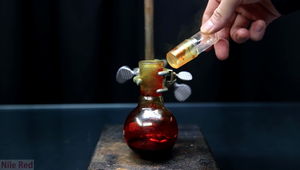Chromyl chloride
 Chromyl chloride fuming in air
| |
| Names | |
|---|---|
| Preferred IUPAC name
Chromium(VI) dichloride dioxide | |
| Systematic IUPAC name
Dichlorodioxochromium | |
| Other names
Chromic oxychloride, chromium chloride oxide, chromium dioxychloride, chromium dichloride dioxide, chromium dioxide dichloride, chromium oxychloride, chlorochromic anhydride
| |
| Properties | |
| CrO2Cl2 | |
| Molar mass | 154.9008 g/mol |
| Appearance | Viscous fuming blood-red liquid |
| Odor | Acrid, burning |
| Density | 1.96 g/cm3 (at 20 °C) |
| Melting point | −96.5 °C (−141.7 °F; 176.7 K) |
| Boiling point | 117 °C (243 °F; 390 K) |
| Reacts | |
| Solubility | Reacts with alcohols, toluene Soluble in glacial acetic acid, benzene, carbon disulfide, carbon tetrachloride, chloroform, dichloromethane, diethyl ether, nitrobenzene, phosphoryl chloride |
| Vapor pressure | 20 mmHg (at 20 °C) |
| Hazards | |
| Safety data sheet | Acros |
| Flash point | Non-flammable |
| Related compounds | |
| Related compounds
|
Chromic acid |
| Except where otherwise noted, data are given for materials in their standard state (at 25 °C [77 °F], 100 kPa). | |
| Infobox references | |
Chromyl chloride is an inorganic chemical compound, used as an oxidizing agent, mostly in organic chemistry. It is an opaque dark blood-red liquid at standard conditions.
Contents
Properties
Chemical
Chromyl chloride will oxidize toluene to benzaldehyde. This reaction occurs in two steps:
First, a chromium compound is formed from the chromyl chloride and toluene:
- C6H5CH3 + 2 CrO2Cl2 → C6H5CH[CrO2Cl2]2
The complex is hydrolyzed with water to yield benzaldehyde.
- C6H5CH[CrO2Cl2]2 + 2 H2O → C6H5CH=O + Cr2O3 + 4 HCl
It will react with water to yield chromic acid and hydrochloric acid. The reaction is exothermic.
- CrO2Cl2 + 2 H2O → H2CrO4 + 2 HCl
Physical
Chromyl chloride is a deep red viscous liquid, which fumes in air. It reacts with water, alcohols, but soluble in chlorinated carbons and carboxylic acids.
Availability
Chromyl chloride is difficult to find and due to its hazards, it's difficult to acquire in most countries. It's best to make it yourself, though you better have a good ventilation if you attempt to make it, as it's a nasty thing.
Preparation
Chromyl chloride can be made by reacting potassium dichromate with sulfuric acid and sodium chloride:
- K2Cr2O7 + 4 NaCl + 6 H2SO4 → 2 CrO2Cl2 + 2 KHSO4 + 4 NaHSO4 + 3 H2O
A good procedure can be found here.
Chromium trioxide or potassium chromate can also be used instead of potassium dichromate.
Projects
- Make benzaldehyde
- Spontaneous ignition of sulfur
Handling
Safety
Chromyl chloride is extremely corrosive and will fume in contact with air, releasing a mist of hydrochloric and chromic acids. Proper protection must be worn when handling the compound. As it is a Cr(VI) compound, it is also carcinogenic.
Storage
Chromyl chloride must be stored in glass containers, with a proper label and a hazard symbol, away from any moisture or organic compounds. A round bottom flask with a glass stopper can be used. Inspect it periodically to make sure there's no leak and check if the ground joint froze.
Disposal
To safely neutralize chromyl chloride, add the compound in a chilled inert solvent, like chloroform or glacial acetic acid and stir the suspension/solution. Slowly add a reducing agent, such as sodium sulfite/metabisulfite/thiosulfate, ascorbic acid or glucose/sugar until the color changes from red/orange to green. Try to avoid adding aqueous solutions if possible, especially if you're using glacial acetic acid as solvent, as the neutralization will generate heat.
Do this outside or in a fumehood, wearing proper protection.
References
Relevant Sciencemadness threads
- Articles containing unverified chemical infoboxes
- Chemical compounds
- Inorganic compounds
- Chromium compounds
- Oxohalides
- Oxidizing agents
- Materials that react with water
- Materials unstable in acidic solution
- Materials unstable in basic solution
- Things that can kill you very quickly
- Things that should NOT be messed with except by professionals
- Carcinogenic
- Liquids